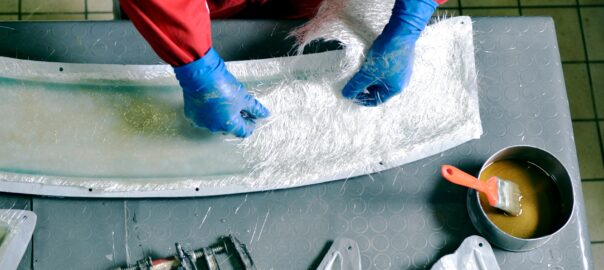In industrial settings, OSHA-compliant safety products are critical for maintaining workplace safety and preventing accidents. Fiberglass Reinforced Plastic (FRP), manufactured through processes like open layup and resin transfer molding (RTM), offers a durable, corrosion-resistant material for producing custom safety components. Fiberglass products provide long-lasting, lightweight alternatives to metal, ideal for applications where environmental durability and non-conductivity are essential.
This article explores the benefits and applications of fiberglass manufacturing safety products that meet OSHA requirements. With expertise from Advanced Fibermolding Inc., a Michigan-based leader in custom fiberglass manufacturing, businesses in agriculture, construction, industrial, and marine sectors can implement OSHA-compliant solutions tailored to their unique operational needs.
OSHA Standards and Requirements Relevant to Fiberglass Safety Products
Several OSHA standards ensure that safety components meet strict guidelines for durability, visibility, and effectiveness:
1910.29: Governs requirements for fall protection systems, including guardrails, handrails, and barriers.
1910.212: Specifies requirements for machine guarding to protect workers from hazardous moving parts.
1910.303: Addresses safety in electrical systems, requiring secure enclosures for high-voltage components and electrical control systems.
fiberglass manufacturing meets these standards with its superior strength, non-conductive properties, and corrosion resistance, offering robust safety products that remain reliable in both indoor and outdoor environments.
Applications of OSHA-Compliant Fiberglass Safety Products
1. Guardrails, Handrails, and Fall Protection
Fiberglass guardrails and handrails offer an OSHA-compliant solution for elevated areas, walkways, and other high-risk zones. Fiberglass is corrosion-resistant and weatherproof, making it ideal for outdoor installations in harsh environments.
Guardrails for Elevated Work Areas: Meeting OSHA 1910.29 requirements, fiberglass guardrails are designed to prevent falls and withstand high impact without corroding over time. They are suitable for elevated walkways, rooftops, and maintenance platforms, particularly in settings exposed to chemicals, moisture, or extreme weather.
Custom Handrails for Ramps and Stairs: Handrails made from fiberglass provide a safe, lightweight solution for stairways and ramps. These handrails can be produced with non-slip surfaces, enhancing worker safety in high-traffic areas.
Advanced Fibermolding Inc. creates custom fiberglass guardrails and handrails tailored to specific site requirements, ensuring durability and compliance with OSHA’s fall protection standards.
2. Machine Guards and Protective Shields
OSHA’s 1910.212 standard mandates effective guarding for machinery to prevent accidental contact with moving parts. Fiberglass guards provide a strong, impact-resistant solution that remains lightweight and flexible, allowing for easy installation and maintenance access.
Protective Guards for High-Risk Machinery: Fiberglass guards are ideal for rotating or hazardous parts like pulleys, belts, and gears. They offer the strength needed to contain sudden movements while protecting employees from accidental contact. Non-conductive fiberglass manufacturing is especially useful for machinery near electrical systems, adding an extra layer of protection.
Shields for Corrosive and Chemical-Exposed Machinery: In facilities with exposure to harsh chemicals, fiberglass guards provide a corrosion-resistant solution that maintains its integrity over time, even in challenging environments.
Advanced Fibermolding leverages its CNC precision cutting capabilities to design machine guards that fit complex shapes, ensuring full coverage and adherence to OSHA’s safety requirements.
3. Electrical Enclosures and Control Panels
Fiberglass enclosures for electrical equipment are essential in environments where non-conductive materials are required for safe handling. OSHA’s 1910.303 standard requires enclosures that protect employees from accidental contact with live parts, particularly in high-voltage or sensitive equipment areas.
Weatherproof Electrical Enclosures: Fiberglass electrical enclosures are non-conductive, corrosion-resistant, and can be used to protect outdoor equipment or electrical systems in damp or chemically exposed environments. These enclosures maintain structural integrity, making them ideal for marine, construction, and industrial applications.
Control Panels and Boxes: Custom control boxes and panels made from fiberglass are secure, impact-resistant, and protect against environmental damage, reducing the risk of electrical hazards. They are ideal for settings with fluctuating temperatures and exposure to corrosive agents.
Advanced Fibermolding’s expertise in resin transfer molding ensures each enclosure is custom-built to fit electrical systems and maintain compliance with OSHA’s electrical safety standards.
4. Containment Covers and Spill Control
OSHA guidelines require appropriate containment for spills, dust, and airborne contaminants, particularly in facilities handling hazardous materials. Fiberglass containment solutions provide strong barriers that prevent spills or debris from spreading, safeguarding workers’ health and reducing environmental hazards.
Spill Containment Covers: Fiberglass spill covers contain accidental leaks and prevent liquids from seeping into floors or work areas. These covers are durable, easy to clean, and resistant to both chemicals and impact.
Dust Containment Shields: In dusty environments, such as woodworking or construction sites, fiberglass containment shields can be used to limit the spread of particulates, keeping air quality safe and protecting employees from respiratory hazards.
With both open layup and RTM capabilities, Advanced Fibermolding produces lightweight yet sturdy containment covers that are easy to install and replace, helping industries comply with OSHA’s environmental safety standards.
5. Rooftop and Elevated Walkway Panels
In facilities requiring rooftop maintenance or elevated walkway access, safety panels and non-slip flooring are essential to prevent falls and injuries. Fiberglass panels provide a secure, lightweight option for these applications.
Non-Slip Walkway Panels: OSHA-compliant fiberglass panels can be installed on rooftops or elevated walkways, providing traction and reducing slip hazards. Textured surfaces add an additional level of safety, ideal for areas exposed to rain, snow, or oil.
Access Pathways for Maintenance: Fiberglass access panels create safe, visible pathways on rooftops or platforms, preventing accidental slips or falls in high-risk areas. These panels are also resistant to UV damage, ensuring longevity even in outdoor settings.
Advanced Fibermolding produces custom-sized walkway panels, designed to fit specific access areas in industrial or commercial facilities, improving safety and OSHA compliance for elevated workspaces.
6. Non-Conductive Barriers for Electrical and Chemical Areas
For industries handling chemicals, volatile substances, or high-voltage equipment, non-conductive barriers are vital for safe operations. Fiberglass barriers provide insulation from electrical currents and resist corrosion from chemicals, making them suitable for highly regulated environments.
Chemical Splash Guards: These barriers protect workers from accidental splashes or spills of hazardous substances. Unlike metal barriers, fiberglass guards won’t corrode, even when exposed to strong acids or bases.
Electrical Isolation Barriers: In high-voltage areas, fiberglass barriers prevent contact with electrical equipment, reducing the risk of electric shock. These barriers can be custom-molded to fit specific equipment layouts, providing flexible, OSHA-compliant protection.
Using high-quality thermoset resins, Advanced Fibermolding customizes these barriers to match each facility’s requirements, ensuring that every component meets OSHA’s strict safety standards.
Benefits of Fiberglass for OSHA-Compliant Safety Products
Fiberglass is uniquely suited to meet OSHA’s requirements for safety components:
Corrosion and Chemical Resistance: Fiberglass remains stable in corrosive environments, ensuring durability for both indoor and outdoor applications.
Lightweight and Non-Conductive: Fiberglass components are much lighter than metal, easy to handle, and non-conductive, ideal for electrical and chemical-sensitive applications.
Customizable for Complex Designs: Fiberglass’s adaptability allows it to be molded into various shapes, sizes, and configurations, making it ideal for diverse safety applications.
Conclusion: OSHA Compliance with Durable Fiberglass Safety Solutions
Fiberglass safety products created through open layup and RTM processes provide strong, OSHA-compliant solutions for protecting employees in high-risk environments. With their durability, non-conductivity, and resistance to environmental damage, fiberglass manufacturing components enhance workplace safety, particularly where exposure to harsh conditions is frequent.
Om Raj Tech and Advanced Fibermolding Inc.: Your Partners in Custom Fiberglass Safety Components
With Om Raj Tech’s representation of Advanced Fibermolding Inc., we offer tailored fiberglass safety solutions that meet OSHA standards. From guardrails and electrical enclosures to chemical splash guards and non-slip walkway panels, Advanced Fibermolding’s expertise ensures high-quality, compliant safety products for agriculture, construction, marine, and industrial clients. Contact us today to learn how our fiberglass manufacturing solutions can support your safety and compliance initiatives.




